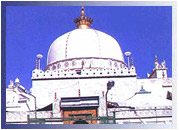
The
small town of Ajmer, 78 miles west of Jaipur, played a surprisingly important
role in India's history. Set at the point where the rocky Aravalli Hills end
and the Thar Desert begins, this was originally the stronghold of the powerful
Chauhan Dynasty of Rajputs, who built India's first ever hill fort here in
the 7th century. Ajmer situated in the green oasis wrapped in the barren hills
has been a witness to an interesting past. The city was founded by Raja Ajai
Pal Singh in the 7th century AD and was brought under the control of Delhi
Sultanate in 1193 when Prthiviraj Chauhan lost it to Mohammed Ghauri. Since
then Ajmer became home to many dynasties. which came and left - leaving behind
indelible marks of their cultutre and traditions on the city's history, converting
it to an amalagam of various cultures and a blend of Hinduism and Islam. Ajmer
also played an important role in paving the way for British East India Company
in India. In 1616, Jehangir met ambassador of King James, Sir Thomas Roe.
That was the first meeting between any Mughal Emperor and representatives
of Britain. In the 17th century, Shahjahan built marble pavilions around the
Ana Sagar Lake. The Taragarh Fort was damaged badly during the Mughal war
of succession between Aurangzeb and Dara Shikoh. Schindi Rulers of Gwalior
took over Ajmer in the mid 18th century, to be handed over to the British
in 1818.
Ajmer is now popular pilgrimage centre for the Hindus as well as the Muslims.
Especailly famous is the Dargah Shariff 0 Tomb of the Sufi Saint Khawja Moinuddin
chisti, Which is equally reverred by the Hindus and Muslims.
Places to see
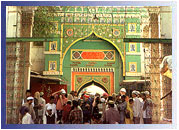 »
The Dargah :
»
The Dargah :
At the foot of a barren hill and in the heart of the city situated India's
most important pilgrimage centre for people from all faiths. It is the splended
tomb of the Sufi Saint Khwaja Moinuddin Chisti, popularly known as Dargah
Shariff. The Shrine is next only to the Mecca or Medina for the Muslims of
South Asia. Akbar used to make pilgrimage to Dargah from Agra once a year.
The Mausoleum has a gigantic gate, which is built by the Nizam of Hyderabad.
The two massive cauldrons in the courtyard are of a particular inerest and
on the right side of the courtyard is the Akbari masjid built in white marble
dome. Thre is another mosque in the courtyard built by Shah Jahan. The saints
tomb with a splended marble domes is in the cnetre of the second courtyard
which is surrounded by silver platform.
The shrines attracts thousands of pilgrims during the Urs - commemorating
the death anniversary of the saint, held from the Ist to 6th day of the Islamic
month of Rajab. A colourful fair that springs up during this time is the major
atraction.
» Shahjahans Mosque : 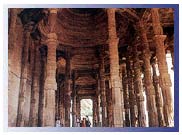
In a far corner of the inner court of the dargah is the magnificent building
in white marble with a long and narrow court having low arcade and delicate
carvings with trellis - work. it is the most marvellous of all the sanctums
within the sanctuary of the Dargah.
» Adhai din Ka Jhonpara
Adhai-din-ka-Jhonpra (two-and-a-half-day shelter) is considered as the first
important Islamic structure to be built in India. According to the legends,
Arhai-din-ka-Jhonpra was a Sanskrit College initially and Mohammed Ghori converted
the college into a mosque within two and a half days, hence the name. According
to another legend, the structure is named after a festival, which carried
on for two and a half days. The monument has seven arched walls with Islamic
calligraphy, though most of it now remains in ruins.
» Taragarh Fort
Taragarh Fort was built on a hilltop by Ajaipal Chauhan, the founder of the
city in the 7th century and is about 3 km from the city of Ajmer. A steep
climb up rewards the weary visitor with an amazing birds eye view of Ajmer.
The Fort was site of thre Military activity during the Mughal period, later
used as a sanatorium by the British.
» The Museum
Once the the royal residence of Emperor Akbar, the museum housesa rich respositry
of the Mughal and Rajput armur and exquisite sculptures.
» Mayo College 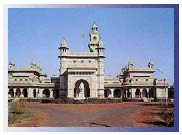
One of the India's best public schools, located in the south east of the city,
it was founded in 1875 AD only for the princes. Each prince alonwith his entire
retinue and English tutor had his own house within the spacious college.
::
Click
here for Reservation
RANTHAMBHORE - GATEWAY TO THE TIGER'S DEN

If
there is park taht can almost guarante tiger sightings, it must be Ranthambhore,
its landscape dominated by Aravalli and Vindhyanchal hill range with its steep
escarpments. Ranthambore - the undisputed thrilling destination to spot Tigers
and numerous animals which we might have never heard of. In Ranthambore you
don't see a Tiger, you see Noon, Laxmi, Noor, Changez, Jhumroo, Jhmri, Machchli,
Bachchi, Sultanpur Mother or Isabelle (named after a BBC's cameraman's daughter).
Experts would take you through various Circuits and would also tell you interesting
story related to each and every Tiger. Ranthambore National Park has an excellent.
::
Click
here for Reservation
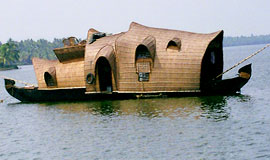
 The
small town of Ajmer, 78 miles west of Jaipur, played a surprisingly important
role in India's history. Set at the point where the rocky Aravalli Hills end
and the Thar Desert begins, this was originally the stronghold of the powerful
Chauhan Dynasty of Rajputs, who built India's first ever hill fort here in
the 7th century. Ajmer situated in the green oasis wrapped in the barren hills
has been a witness to an interesting past. The city was founded by Raja Ajai
Pal Singh in the 7th century AD and was brought under the control of Delhi
Sultanate in 1193 when Prthiviraj Chauhan lost it to Mohammed Ghauri. Since
then Ajmer became home to many dynasties. which came and left - leaving behind
indelible marks of their cultutre and traditions on the city's history, converting
it to an amalagam of various cultures and a blend of Hinduism and Islam. Ajmer
also played an important role in paving the way for British East India Company
in India. In 1616, Jehangir met ambassador of King James, Sir Thomas Roe.
That was the first meeting between any Mughal Emperor and representatives
of Britain. In the 17th century, Shahjahan built marble pavilions around the
Ana Sagar Lake. The Taragarh Fort was damaged badly during the Mughal war
of succession between Aurangzeb and Dara Shikoh. Schindi Rulers of Gwalior
took over Ajmer in the mid 18th century, to be handed over to the British
in 1818.
The
small town of Ajmer, 78 miles west of Jaipur, played a surprisingly important
role in India's history. Set at the point where the rocky Aravalli Hills end
and the Thar Desert begins, this was originally the stronghold of the powerful
Chauhan Dynasty of Rajputs, who built India's first ever hill fort here in
the 7th century. Ajmer situated in the green oasis wrapped in the barren hills
has been a witness to an interesting past. The city was founded by Raja Ajai
Pal Singh in the 7th century AD and was brought under the control of Delhi
Sultanate in 1193 when Prthiviraj Chauhan lost it to Mohammed Ghauri. Since
then Ajmer became home to many dynasties. which came and left - leaving behind
indelible marks of their cultutre and traditions on the city's history, converting
it to an amalagam of various cultures and a blend of Hinduism and Islam. Ajmer
also played an important role in paving the way for British East India Company
in India. In 1616, Jehangir met ambassador of King James, Sir Thomas Roe.
That was the first meeting between any Mughal Emperor and representatives
of Britain. In the 17th century, Shahjahan built marble pavilions around the
Ana Sagar Lake. The Taragarh Fort was damaged badly during the Mughal war
of succession between Aurangzeb and Dara Shikoh. Schindi Rulers of Gwalior
took over Ajmer in the mid 18th century, to be handed over to the British
in 1818.  »
The Dargah :
»
The Dargah : 

 If
there is park taht can almost guarante tiger sightings, it must be Ranthambhore,
its landscape dominated by Aravalli and Vindhyanchal hill range with its steep
escarpments. Ranthambore - the undisputed thrilling destination to spot Tigers
and numerous animals which we might have never heard of. In Ranthambore you
don't see a Tiger, you see Noon, Laxmi, Noor, Changez, Jhumroo, Jhmri, Machchli,
Bachchi, Sultanpur Mother or Isabelle (named after a BBC's cameraman's daughter).
Experts would take you through various Circuits and would also tell you interesting
story related to each and every Tiger. Ranthambore National Park has an excellent.
If
there is park taht can almost guarante tiger sightings, it must be Ranthambhore,
its landscape dominated by Aravalli and Vindhyanchal hill range with its steep
escarpments. Ranthambore - the undisputed thrilling destination to spot Tigers
and numerous animals which we might have never heard of. In Ranthambore you
don't see a Tiger, you see Noon, Laxmi, Noor, Changez, Jhumroo, Jhmri, Machchli,
Bachchi, Sultanpur Mother or Isabelle (named after a BBC's cameraman's daughter).
Experts would take you through various Circuits and would also tell you interesting
story related to each and every Tiger. Ranthambore National Park has an excellent.